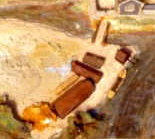| the wharf | |
|
|
|
|
|
|
| A diorama of the Abbey wharf in 1410 viewed from the south, in the Museum of Reading. Copyright Reading Museum Service (Reading Borough Council). All rights reserved. | |
|
The Abbey Wharf began as a shelving bank of the river Kennet on which stones were dumped to make it firmer for boats to be drawn up out of the water. It was here that the loads of stone arrived from Caen in northern France for building the Abbey. And probably here also the body of Henry 1 reached the Abbey for burial after a sea voyage following the death of the king in France. Later the west bank of the Kennet was extended by dumping a vast amount of clayey soil and constructing a timber frontage to the river so that boats could moor against the
wharf side. Upright squared-off timbers with tapered ends were driven into the river bed every 75 centimetres. Behind these were horizontal planks holding back the river bank. All this timber work was in oak. On the wharf side was a stone building and a less substantial wooden building adjacent to it on the north. Mediaeval roads were very poor, being cart- tracks with no make-up of stone and
impossibly muddy in wet weather. Water transport was therefore used whenever possible, especially for carrying bulky goods, and the Abbey Wharf was in constant activity. The bargemen there, humping sacks of grain for the Mill, wine imported from the continent, bundles of fire-wood, could he free in their language and the noise disturbed the monks in their Cloister only 140 metres to the north. We know this because of a written complaint in the margin of a book being copied out there. Some of the mediaeval swear words have come down to be still used now: 'By our Lady' - 'Bloody', 'God blind me' - 'Cor blimey'. Others -'Gods wounds' - Zounds', have gone out of fashion.
The excavations at the Reading Abbey Waterfront have been published in the following list:- Fasham, P J & Hawkes, J W 1984 `Reading Abbey waterfront [AD 1175 onwards]' Popular Archaeology 5 (7), Jan 1984 37-40. Fasham, Pete & Hawkes, John 1983 `Reading Abbey rediscovered [recent excavations of its waterfront, etc]' Trust for Wessex
Archaeology/Reading Museum & Art Gallery [Reading]. Hawkes J and P J Fasham 1997, Excavations on Reading Waterfront Sites, 1979 - 1988, Wessex Archaeology Report 5. Copyright Reading Museum Service from "Reading Abbey", published by Reading Museum & Art Gallery 1988. click to return to Discovering Reading Abbey |
|
